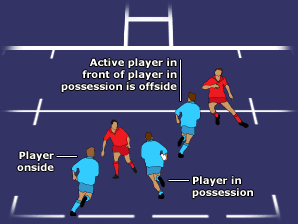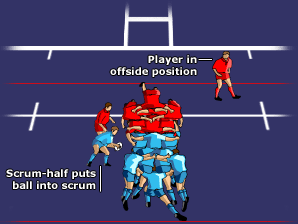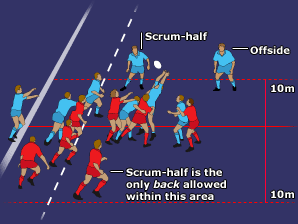Rugby - 101
The Laws of Rugby
The Basics - Scrummaging - Line-out - Ruck - Maul - Offside - Tackling
5-metre Scrum - Mark - Sin-Bin
- Actively try to play the ball
- Do not retreat within 10m of an
opponent who is waiting for the ball
- Move towards the opponents or
the place where the ball lands without first coming back onside
The referee will award a penalty at the place where the offence took place.

That means they can't go beyond that line until the ball has been put into the scrum by the opposing number nine.
For all the other players, the offside line is an imaginary line drawn through the 'hindmost' foot of the last player in the scrum.
No player apart from the eight forwards and scrum-halves are allowed within this area.
The opposing scrum-half has to wait until the ball is out of the scrum before making a tackle for the ball.
If they don't, the referee will award a penalty.

Like the scrum, an imaginary line is drawn through the hindmost foot of the last player in the ruck or maul.
Players must either join the ruck or maul or retreat behind the offside line.
A player is offside if they:
- Join from their opponent's side
- Join play from in front of the
last man
- Do not join either the ruck or
maul, but fail to get behind the offside line
- Leave the ruck or maul, but do not get behind the offside line.

Effectively they make a box which is 10m wide either side of the line-out.
Only the forwards and the scrum-half are allowed in this area until the ball has been thrown in, touched a player or the ground.
The referee will create a one-meter gap between the two lines of forwards. This is the offside line between the two sets of forwards.
Players must not encroach within this gap until the ball has touched a player or the ground, unless they are jumping for the ball.
No player can leave the line-out until it has finished.

If they are not, the referee will award the opposition a penalty.
If the player is in front of the kicker already, they cannot get involved with open play.
Players often raise their arms when running back to an onside position.
This shows the referee that they have no intention of joining play because they are in an offside position.

